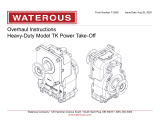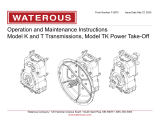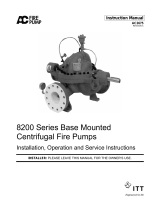
CP3-500 Body and Impeller Shaft Assembly
Overhaul Instructions
Table of Contents
Introduction ........................................................... 1
General Overhaul Information ............................. 1
Tools and Equipment ...................................... 1
Preliminary Testing ......................................... 1
Cleaning ......................................................... 1
Pump Bodies and Impellers ............................ 1
Bearings, Gaskets, Seals and O-rings ............ 1
Impeller Shafts ............................................... 1
Installing Ball Bearings ................................... 1
Disassembling Transmission from Pump .............. 2
Disassembling Intake and Discharge Adapters ..... 3
Disassembling Mechanical Seal Piping ................. 4
Transfer Valve ...................................................... 5
Mechanical Seal Removal from Transmission End 6
Disassembling Inboard Head ................................ 7
Disassembling Outboard Bearing ......................... 8
Bearing Puller ....................................................... 9
Mechanical Seal Removal from Outboard End ..... 10
Disassembling Outboard Head and Impeller ......... 11
Impeller and Wear Ring Repair Dimensions ......... 12
Interstage Seal Removal ...................................... 13
Reassembling Outboard Head and Impeller ......... 14
Mechanical Seal Assembly on Outboard End ....... 15
Reassembling Outboard Bearing .......................... 16
Bearing Assembly Tool ......................................... 17
Reassembling Inboard Head and Impeller ............ 18
Mechanical Seal Assembly on Transmission End . 19, 20
Reassembling Pump and Transmission ................ 21
.
Note: Instructions subject to change without notice.
F-1031, Section 4215 (Rev: 7/12/23)
Waterous Company 125 Hardman Avenue South, South St. Paul, Minnesota 55075 USA (651) 450-5000
www.waterousco.com

Introduction
This instruction contains the information needed to overhaul and repair
Waterous CP series centrifugal fire pumps.
The text uses reference numbers when discussing specific parts. These
numbers refer to the parts called out on the Service Parts List which is
supplied with the pump.
General Overhaul Information
Tools and Equipment
The following tools and equipment are needed to overhaul a pump:
1. Usual automotive mechanic's hand tools.
2. An arbor press for assembling or disassembling components.
3. An engine lathe for turning impeller hubs.
4. A suitable hoist and slings.
5. Torque capability up to 325 lb-ft.
While no special tools and equipment are required, a few special items are
illustrated or described so the mechanic can make them or they are avail‐
able from the apparatus manufacturer or the Waterous Company. These
special items are not absolutely necessary, but they will make the
mechanic's work much easier.
Preliminary Testing
Before disassembling a pump, test it thoroughly, if possible, and record the
results. A comparison of this test with periodic tests recommended in form
F-1031, Section 1000 can often reveal specific pump troubles. Excessive
speed, for instance, indicates that impellers and/or wear rings are probably
worn.
Cleaning
The continued satisfactory operation of a pump depends to a great extent
upon the cleanliness of its internal parts. Sand, dirt or other abrasive
material will wear bearings, gears and related parts. Before disassembling
a pump for repairs, be sure to clean its exterior. Make sure the working
space, benches and tools are clean. Use only clean, lint-free cloths to
wipe off components. Before reassembling a pump or its components, be
sure to clean them thoroughly.
Pump Bodies and Impellers
Flush out these components and related parts with clean water. Use a stiff
brush to remove loose scale, caked sediment, etc. Be sure to remove all
traces of old gaskets. Examine pump bodies, covers, adapters and fittings
for cracks, severe corrosion or other damage. Almost all damage to these
parts results from improper use or maintenance, or from freezing. Replace
defective parts.
Bearings, Gaskets, Seals and O-rings
Parts of this nature are frequently damaged during removal or
disassembly. In addition, they sometimes deteriorate or lose their
effectiveness because of age or misuse. Replacing these parts whenever
overhauling a pump is a good policy.
Impeller Shafts
Examine shaft for severe scratches, grooves or corrosion - especially
under packing or mechanical seals. If scratches are not severe, and are
not under packing and seals, clean them with a fine-cut file. Grooves are
usually permissible if they are not sharp or too deep. Even slight
longitudinal scratches will cause leaks and should be removed.
Installing Ball Bearings
Most Waterous pumps are designed so that ball bearings fit tightly on their
shafts and have relatively loose fits in the bearing housings. When
mounting these bearings on shafts, always apply force to the inner races.
When bearings have a tight fit in the housings, and a heavy force is
necessary to install them, be sure to apply force only to the outer bearing
races. For either type of fit, applying force to the wrong bearing race may
damage the balls and race.
6. Position the impeller shaft assembly in a vertical position in an arbor
press with the spline end of the shaft up and the impeller end of the
outer race of bearing (S15) supported by the table of the press. Press
the shaft (S9) out of the bearings (S13 & S11), spacer (S12) and oil
seal sleeve (S14).
F-1031, Section 4215 Page 1 of 21

F-1031, Section 4215
Page 2 of 21
Disassembling Transmission from Pump
7. Remove the four cap screws and lock washers that attach
the transmission to the head assembly.
8. Pull transmission straight back from head.
9. Remove suspension bracket from pump body.

F-1031, Section 4215
Page 3 of 21
Intake Fitting
Disassembling Intake and Discharge Adapters
Flap Valve Discharge Fitting
1. Remove the hex hd screws and nuts that
attach the intake and discharge fittings to
the pump body.
2. Remove the fittings and the gaskets.
3. Remove the flap valve and bushings, check
for damage or corrosion.
IL1099

F-1031, Section 4215
Page 4 of 21
Disassembling Mechanical Seal Piping

F-1031, Section 4215
Page 5 of 21
Spirol Pin
Clevis Pin
Cotter Pin
Plain Washer
Transfer Valve Arm
Sleeve bearing
Cotter Pin (2)
Pivot Pin
Transfer Valve
Note: The transfer valve only needs to be removed
and
disassembled if it needs to be repaired.
Before disassembling transfer valve make sure the
arrows are still visible on the transfer valve stem
and
sector gear. If the arrows are worn off, mark the
stem and
sector gear so they line up correctly during
reassembly
.
Sector Gear
Socket Hd Screw
Sector Gear
Spring Flat Copper Washer
Transfer Valve Cover
Groove Pin
Spring
Housing
Cover Gasket
Plain Washer
O-ring, 1 x 1-1/4 in.
Groove Pin,
1/4 x 1-3/4 in.
O-ring, 2-1/2 x 2-3/4 in.
Transfer Valve Housing
Note: Before disassembling
transfer valve cover, mark the
ear on the transfer valve
housing and the slot on the
cover so they are
reassembled correctly.
Transfer Valve
Transfer Valve
Note: Make sure the arrows on the
sector
gear and transfer valve line up
and the
groove pin is perpendicular to
the arrow when the transfer valve is
reassembled.
1104

F-1031, Section 4215
Page 6 of 21
Mechanical Seal Removal from Transmission End
Retaining Ring
Mechanical Seal
1. Remove the four socket head screws
that attach the mechanical seal
housing.
2. Remove the mechanical seal housing.
3. Remove the mechanical seal
4. Remove retaining ring from behind
mechanical seal.
5. Push out throttle bushing to remove
mechanical seal stationary ring.
Mechanical Seal
Stationary Ring
Throttle Bushing
Mechanical Seal
Stationary Ring
O-Ring O-Ring
Mechanical Seal Housing
Socket Head Screw, 1/4-20 x 1-1/4 in.
Throttle Bushing
1105, 1117

F-1031, Section 4215
Page 7 of 21
Disassembling Inboard Head
Wear Ring
Retaining Ring
Hex Hd Screw,
7/16-14 x 1 in.
1. Remove the 12 hex hd screws and
washers that attach inboard head to
body.
2. Use jacking screws to remove inboard
head.
3. Remove O-ring.
4. Check the head bushing and replace if
worn. The original inside diameter of this
bushing is 1.084/1.085.
5. Remove retaining ring.
6. Remove impeller and check wear rings,
remove only if worn. See page 11 for
wear ring repair dimensions.
Note: The impeller is a press fit
on the shaft.
Flat Copper Washer
Impeller
Head Bushing
O-Ring
Screw in jacking hole
Inboard Head
IL1106

F-1031, Section 4215
Page 8 of 21
Disassembling Outboard Bearing
1. Remove four hex hd screws and lock washers
that attach bearing housing cover to bearing
housing
2. Remove bearing housing cover and gasket.
3. Remove retaining ring.
4. Remove four screws and lock washers that
attach attach bearing housing to outboard head.
5. Use bearing puller to remove bearing from
shaft. (See page 9 for bearing puller.)
6. Remove flinger ring.
Note: The flinger ring is on the shaft with a
press fit.

F-1031, Section 4215
Page 9 of 21
1-3/4
3-1/2
1-3/8
2-3/4
Bearing Puller
Bearing Puller
Ball Bearing
1119
Bearing Housing Mechanical Seal
Mechanical Seal Housing
Flinger Ring
1/2
1”
1/2
5/16 DIA, 2 Holes
3/8-16 x 3 in. Screw
3/8-16 UNC TAP 1121

F-1031, Section 4215
Page 10 of 21
Mechanical Seal Removal from Outboard End
Socket Head Screw, 1/4-20 x 1-1/4 in.
Mechanical Seal Housing
O-Ring
Throttle Bushing
1. Remove socket head screws that attach mechanical seal
housing to outboard head.
2. Remove mechanical seal housing.
3. Remove mechanical seal.
4. Remove retaining ring from behind mechanical seal.
5. Push out throttle bushing to remove mechanical seal
stationary ring.
Mechanical Seal Stationary Ring
Mechanical Seal
Retaining Ring Mechanical Seal
Stationary Ring
Outboard Head
O-Ring
1110
Throttle Bushing

F-1031, Section 4215
Page 11 of 21
Head Bushing
Disassembling Outboard Head and Impeller
Hex Head Screw, 7/16-14 x 1 in.
Flat Copper Washer, 7/16 in.
Jacking Screw Outboard Head
O-Ring
Retaining Ring
Wear Ring
1. Remove the 12 hex hd screws and washers that
attach inboard head to body.
2. Use jacking screws to remove inboard head.
3. Remove O-ring.
4. Check the head bushing and replace if worn. The
original inside diameter of the bushing is
1.084/1.085.
5. Remove retaining ring.
6. Remove impeller and check wear rings, remove only
if worn. See page 11 for wear ring repair dimensions.
Note: The impeller is a press fit on the shaft.
Square Key,
1/4 x 1/4 x 1 in.
Impeller
Wear Ring
Impeller Shaft
1108

F-1031, Section 4215
Page 12 of 21
Impeller and Wear Ring Repair Dimensions
Impeller
Number
Original
Hub Dia
Factory
Clearance
Maximum
Clearance*
Original Wear
Ring
Number
Reworked
Hub Dia
A
New Wear
Ring
Number
70966-1
70967-1
3.748/3.747
0.013/0.010
0.0195
61363
3.723/3.721
3.698/3.696
3.673/3.671
61363-25
61363-50
61363-75
72244-1
72245-1
2.875/2.874
0.013/0.010
0.0195
61436
2.850/2.848
2.825/2.823
2.800/2.798
61436-25
61436-50
61436-75
*This is the suggested maximum wear ring clearance before reworking or replacing the impeller and wear rings.
A A
1126
Installing Undersize Wear Rings
1. Check wear rings and impeller hubs for deep grooves or scratches.
2. If inspections shows that the wear ring clearances are excessive
(diametral clearance in excess of .019), or if the impeller hubs are
scored or grooved, use the dimension in the table above to rework the
hubs.
3. The diametral clearance is determined by averaging the results of four
measurements taken at 90° increments.
4. Repair rings are available 0.025, 0.050 or 0.075 inches undersize.
The table gives the original hub dimension for each impeller and the
rework dimensions for each degree of undersize.
If pump uses ``L'' shaped wear rings (61436), install them
with
the wide machined face of the rings away from the
impellers.

F-1031, Section 4215
Page 13 of 21
1st
ST
AGE
2nd
ST
AGE
Interstage Seal Removal
1127 Interstage Seal
The interstage seal seldom needs to be replaced. If the total
clearance between the interstage seal and the impeller shaft is
much greater than 0.030 inches, replacing the seal may be
desirable.
The interstage seal can only be removed from the second stage
end using a press.
1128
Interstage Seal

Head Bushing
Reassembling Outboard Head and Impeller
Hex Head Screw, 7/16-14 x 1 in.
Flat Copper Washer, 7/16 in.
Outboard Head
O-Ring
Retaining Ring
Wear Ring
1. Replace the wear rings in the outboard head
and pump body.
2. Replace the key on the outboard end of the
shaft.
3. Press the impeller on the shaft with the eye
opening facing in.
4. Install retaining ring.
5. Install impeller and shaft in the pump body.
6. Install head bushing in the outboard head.
7. Place O-ring in groove of outboard head,
holding it in place with grease.
8. Assemble outboard head to pump body using
twelve copper washers and hex head screws.
Square Key,
1/4 x 1/4 x 1 in.
Impeller
Wear Ring
Impeller Shaft
1108
F- 1, Section 4215 Rev: 03/02/16 Page 14 of 21

F-1031, Section 4215
Page 15 of 21
Mechanical Seal Assembly on Outboard End
Socket Head Screw, 1/4-20 x 1-1/4 in.
Mechanical Seal Housing
O-Ring
Throttle Bushing
CAUTION
The mechanical seal primary and stationary
rings are made of brittle material. The material
can be cracked or chipped. Extra care must be
taken when handling these rings.
Note: If Waterous Mechanical Seal Lubricant
part no. 52608 is not available, P80 rubber lubri‐
cant, straight dish soap or glycerin may be
substituted.
Clean these two surfaces
with denatured alcohol
Retaining Ring
Mechanical Seal Stationary Ring
Mechanical Seal
1. Replace retaining ring.
2. Install mechanical seal on shaft using mechanical
seal lubricant.
3. Replace throttle bushing and mechanical seal
stationary ring in the mechanical seal housing.
4. Replace O-ring on the mechanical seal housing.
5. Clean face of mechanical seal and stationary ring
with denatured alcohol.
6. Use the four socket head screws to install the
mechanical seal housing on the outboard head
with the hole for the piping facing down.
Outboard Head
Mechanical Seal
Stationary Ring
O-Ring
1110
MECHANICAL SEAL INSTALLATION TOOL
Throttle Bushin

F-1031, Section 4215
Page 16 of 21
Reassembling Outboard Bearing
1. Replace flinger ring, large diameter in.
2. Install bearing housing using four lock washers and
screws.
3. Install bearing, shield side in, using bearing
installation tool shown on page 16.
4. Install retaining ring.
5. Replace cover gasket and install bearing housing
using four hex head screws and lock washers.
6. Install lubrication fitting and grease bearing on pumps
made prior to June 27, 2023.
(Not required if converting to new style ball
bearing and housing cover)

F-1031, Section 4215
Page 17 of 21
Bearing Assembly Tool
Bearing
1146
Bearing Assembly Tool
1120

Page 18 of 21
F-1031, Section 4215
Reassembling Inboard Head and Impeller
Key
Wear Ring
Retaining Ring
Hex Hd Screw,
7/16-14 x 1 in.
1. Replace the wear rings in the outboard head
and pump body.
2. Replace the key on the impeller shaft.
3. Press impeller on the impeller shaft with eye
opening facing in.
4. Install retaining ring.
5. Install head bushing.
6. Place O-ring in groove of inboard head, holding
it in place with grease.
7. Assemble inboard head to pump body using
twelve copper washers and hex head screws.
Flat Copper Washer
Impeller
Head Bushing
O-Ring
Inboard Head 1106

Page 19 of 21
F-1031, Section 4215
Mechanical Seal Assembly on Transmission End
CAUTION
The mechanical seal mating ring is made of
silicon carbide. The material is brittle and can
be cracked or chipped. Extra care must be
taken when handling the mating ring.
O-Ring
Mechanical Seal
Stationary Ring
Clean these two surfaces
with denatured alcohol
O-Ring
Retaining Ring
Mechanical Seal
Mechanical Seal
Stationary Ring
Throttle Bushing
Note: If Waterous Mechanical Seal Lubricant
part no. 52608 is not available, P80 rubber lubri‐
cant, straight dish soap or glycerin may be
substituted.
1. Replace retaining ring.
2. Install mechanical seal on shaft using
mechanical seal lubricant.
3. Replace throttle bushing and mechanical seal
stationary ring in the mechanical seal housing.
4. Replace O-ring on the mechanical seal
housing.
5. Clean face of mechanical seal and stationary
ring with denatured alcohol.
6. Use the four socket head screws to install the
mechanical seal housing on the inboard
head with the hole for the piping facing
down.
7. Rotate impeller shaft to make sure it runs
freely.
Mechanical Seal Housing
Socket Head Screw, 1/4-20 x 1-1/4 in.
Throttle Bushing
1105, 1117
Page is loading ...
Page is loading ...
/










